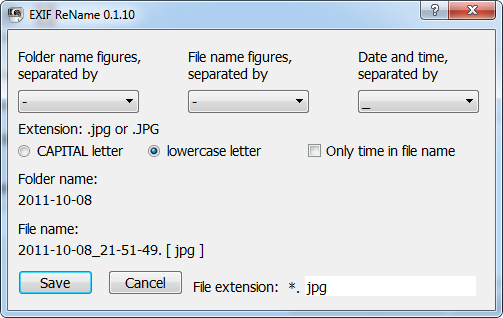
- Use exiftool to rename files with camera model how to#
- Use exiftool to rename files with camera model mac os#
- Use exiftool to rename files with camera model update#
To remove ALL (nearly all) EXIF data, you would use a command like this:
Use exiftool to rename files with camera model how to#
Here are some handy examples of how to use exiftool.įirst, we've seen how to display all of the EXIF data by typing "exiftool" followed by the file name.
Typing "exiftool" followed by "-h" displays a man page To make changes to the data, you would use an exiftool command on the command line. The result would look like the samples displayed above, but you should expect see 80 lines or more of descriptive information. Alternately, you can type "exiftool" followed by a blank and then drag the image into the window and then press enter. All of these things can easily be done with exiftool.Īfter installing exiftool, you would open a terminal or cmd window and type "exiftool" followed by the You might also sometimes want to add data - for example, to insert a copyright notice into your image files. Or you just might not want the extra data adding bulk to the size of your files. Or you might not want anyone to know where you were a photo was shot or the date and time that it was shot. These might comprise your own kind of "photography trade secret". Very serious photographer, you might not want to share all the details of how you made the shot. Sometimes, you might want to remove, change, or simply examine this data. Like this, pinpointing the location with considerable precision: Geotagging causes the longitude and latitude to be captured. The data that had piqued my curiosity - the orientation or "rotation" of the image - was stored in a field that was displayed like this:
Use exiftool to rename files with camera model mac os#
The data doesn't look like this within the image, of course, but has been extracted with a tool called exiftool that works on Linux, Mac OS X, and Windows and labels the fields as shown to make the data more usable.įile Modification Date/Time : 2015:10:30 19:34:15-04:00įile Access Date/Time : 2015:10:31 19:36:23-04:00įile Creation Date/Time : 2015:10:30 19:27:20-04:00Įxif Byte Order : Big-endian (Motorola, MM) Some of the type of information that is stored is shown in the data sample below.
Use exiftool to rename files with camera model update#
In addition, when I update an image with Gimp, say to crop it or rotate it 90 degrees, Gimp also adds And, if your phone/camera has geotagging turned on, it will also include the altitude, longitude and latitude of the place where the photo was taken. This information is quite extensive - depending on the digital camera you're using, containing detailed information about the photo such as the make and model of the digital camera that was used, whether a flash was used, the focal length, light value, and the shutter speed that was used when it was taken. Stored in the EXIF (exchangeable image format) data that is incorporated into the jpg (and tiff) photos.

To begin, all the metadata regarding the photos that we take with our digital cameras and phones are OK, so what's going on and how much information is stored and where? The only real surprise was that I'd never really paid much attention to this before. This told me, unless these tools were both doing an extremely clever image analysis, 1) that my phone was smarter than I thought as it clearly was able to detect and record its orientation and 2) that this information was stored within my photos. That is, I'd taken them with my digital camera (OK, my iphone) turned sideways. Why? Because, when I added an image to my Facebook page or opened one up to do a little cropping with Gimp, it was obvious that both Firefox and Gimp knew that some of my images were rotated. I was filing some of my 2015 family photos and started thinking about how much more complex the jpg format had become since I first did a deep dive into it more than twenty years ago. My curiosity about the kind of metadata that was stored inside the photos I've been taking with my iPhone arose only recently. Ever wonder about how much information is stored in your image files beyond the pixels that comprise the images themselves? And what that data might tell about you, your camera, your photographic style, and your location? It just might be a lot more than you ever imagined.


 0 kommentar(er)
0 kommentar(er)
